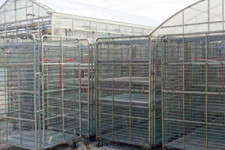Counting On Carts

Keeping track of carts and making sure there is enough on hand for shipments when spring gets rolling is an issue for wholesale growers of all sizes, whether they serve large retailers or independent garden centers.
Take Robin Waldrop Sr. of First Stage Greenhouses near South Bend, Ind., who serves garden centers within a 150-mile radius. He takes good care of his carts and hates to see them swapped out with old rusty ones in exchange on a return trip.
“The problem I’ve run into geographically is other growers using the same type of cart as us,” he says. “It’s tough to ship new carts out and get old ones back, even though they are the same type. We have all our wholesale customers unload them while our drivers wait. It’s worth it for me to pay my drivers to wait rather than wondering where my carts are, or worse yet, getting the same type of carts back that are either rusty, old, damaged or have other problems. Yeah, our customers would love to see us drop and run, but it only took one season for me to say enough is enough!”
Waldrop uses the Big Boy carts from Cart Mart, which fit well on his two 26-foot-long straight trucks. In addition to shipping, they are handy for growing products outside, like flats of strawberries. His fleet has grown to 36 carts.
Bettinger Farms near Toledo, Ohio, builds its own heavy-duty racks and prefers to have them back. In addition to being painted blue to stand out, they weigh at least 300 pounds, are not on wheels and require a forklift to move them. No one is going to walk off with these babies. Each rack holds 80 flats or 48 4 ½-inch pots or 36 hanging baskets.
Bettinger does ship farther distances to Southern markets and even the Northeast. “We keep track of each load we ship out,” Deb Bettinger says. “Our larger customers are allowed to keep one set, so that during the heat of the season, we drop off 28 full and pick up 28 empty. Some will unload the plants from our racks and put them right back on the truck. It depends on how many times we deliver each week. Our customers and our drivers are really good about bringing back a whole load each drop. They know it costs a lot for us to drive around the countryside picking up racks.”
Bettinger Farms has 638 racks this year and nearly runs out every year. “Each year, we add a few more during the downtime,” Bettinger says. “People here make them. We buy the steel, which is expensive. We take out all our boards every year and keep them inside and paint them, as needed. It is important to have our product on nice-looking racks.”
A Shared Solution
Container Centralen hasn’t given up trying to start a European-style cart rental system in the United States. Based in Florida, its Danish parent company operates the cart pool that provides the standard shipping platform for all live plant shipments across Europe. The challenge here is too many growers have made too big of an investment owning carts that are not standardized. But little by little, more growers are devoting at least a portion of their carts to this pool.
“Container Centralen’s (CC) U.S. business added 50,000 new carts to support growth in 2011. This means CC will offer 300,000 carts to U.S. customers for the 2011 season,” Container Centralen USA’s Sonny Costin says. “We offer the largest pool of carts in the United States and have grown rapidly since our startup in 2005.”
Last year, CC implemented a tracking system based on RFID. Costin says this is the largest implementation of this technology in the United States. This year, CC is offering its RFID tracking system for use on customer-owned carts, meaning growers can have one system for tracking CC carts as well as their own. “The CC tracking system allows customers to track shipment of carts to retail stores or shipments to other growers,” Costin says. This is especially helpful for growers who provide carts to contract growers.
Catering To Growers
In the last 25 years, cart manufacturers have emerged who specialize in our industry and have been evolving to meet market needs. Wellmaster in Canada offers carts for transportation, retail display and that serve both purposes. “Carts have become increasingly important to growers and their customers as they seek ways to do more with less,” Wellmaster’s Doug White says. “Better utilization of all their resources–labor, fuel, space and equipment–has encouraged growers to look to every means possible, including the use of carts to improve their response time, improve efficiency and customer service levels.”
To provide competitive pricing, Wellmaster offers a North American-manufactured cart, an Asian-manufactured cart or a hybrid with parts made in Asia and North America. “The prices, minimum order quantities and lead times (delivery dates) differ and the grower is given the option of choosing,” White says.
Cart Mart, which supplies the Big Boy carts Waldrop uses, is part of Matco Distributors in Milwaukee, Wisc. Dennis Doran, who heads up the Cart Mart division, says nearly all the carts are produced in China because it’s too cost prohibitive in the United States. “Larger growers are going to China and buying directly,” Doran says. “While we have a few customers who will buy container loads, most of our customers are smaller growers who can’t afford to buy directly from producers in China. We are the insurance policy and bring carts to our place in good condition ready to use. We are the big buyers. This year, we sold out of everything we have for horticulture. There’s a 10-week lead time to order from overseas. Through trial and error, we have learned hard lessons and landed with people who are reputable and have representatives in the United States.”
The rise of growers serving large retailers is driving demand for carts. “Big box stores keep getting bigger and are demanding service from one major supplier instead of 10 to 12 different vendors at the garden center,” Doran explains. “Smaller guys grow for the larger growers, who handle the distribution. It’s easier if the product is on a cart. Larger growers buy carts to send to the contract growers.” He adds carts are prevalent at retail as Home Depot transforms part of a parking lot and makes shopping aisles out of carts.
One newer supplier is Pride Garden Products, which got into carts five years ago at the request of Bell Nursery, which was seeking an alternative manufacturer and was a Pride customer for coco fiber baskets. As a steel and metal manufacturer, Pride explored cost-effective options to provide quality carts.
President Ravi Rajagopalan says Pride designed the carts with retail considerations in mind. “Growers are not just transporting plants from point A to point B. The carts are a display vehicle for them,” he says, adding that important considerations are good wheels and excellent rolling capabilities, the ability to lock the wheels for safety, and for the carts to be light enough for female merchandisers to maneuver them at the stores.
“We continue to do a lot of research and development, looking at display systems and getting ideas from Europe, especially Dutch and German growers,” he says. More could be done to create attractive display units for indoor plants, he says.
Getting the design and dimensions of the cart right is critical. “We invest in CAD (computer aided design) drawings and make sure the customer clearly understands the product he will be receiving,” Rajagopalan says. “If we deliver carts that are the wrong height, it shoots the whole season down. Even an inch taller, longer or shorter is a problem when loading trucks or products on shelves. Carts may not be as glamorous as a pot or a basket, but they are necessary equipment growers must have and must have on time.”









